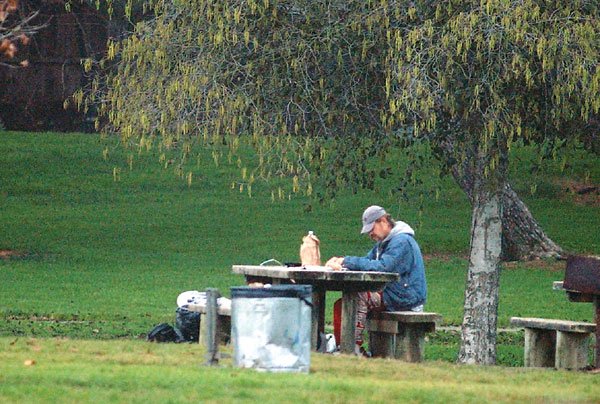
Gilroy
– They are out there, unnoticed by the unaccustomed eyes of most
Gilroy residents, living in broken down school buses, sleeping in
the bathrooms at Las Animas Veterans Park, trying to escape
detection by the police and anyone else who might give them a hard
time.
Gilroy – They are out there, unnoticed by the unaccustomed eyes of most Gilroy residents, living in broken down school buses, sleeping in the bathrooms at Las Animas Veterans Park, trying to escape detection by the police and anyone else who might give them a hard time.
Tiger, who’s been on the street for almost a year while his wife and three kids stay with a relative, puts it this way: “I got laid off from Gilroy Foods, I’ve been looking for work all the time for a year. The people with big fancy houses need to look at the real picture. This place has gone to s – – -.”
Homeless advocates say that Gilroy has the highest per-capita street population in Santa Clara County. In a few months everyone will know for sure, with the results of the first street-by-street homeless count in county history.
Tuesday was the first day of a two-day project to look under every bridge and behind every abandoned shack to get the most accurate count possible of the county’s homeless population, necessary if the county is receive federal funds adequate to serve their needs.
Drawn by a desire to help and the promise of $10 an hour, homeless and former homeless made up the majority of the 24 volunteers who showed up at Saint Joseph’s Family Center at 4:30 Tuesday morning.
The early wake-up call is key to getting an accurate count. The National Guard Armory on Wren Avenue sends its overnighters back to the streets by 7am. If the shelter population is on the street with the counters, they’ll be counted twice.
The count has been demanded by the federal government, which has promised a bump in funding to municipalities that can reliably demonstrate need. In the past, the Santa Clara County Collaborative on Affordable Housing and Homeless Issues has relied on counts from the county’s 27 shelters. This week, counts will be taken from transitional housing sites and every last street as well.
“The Interagency is dangling a carrot,” said Margaret Gregg, homeless concerns coordinator for the county. “They will make grants in the spring to any community that has a plan. We’re trying to be in a position to get some of that money.”
To that end, the Collaborative will host the first meeting of a new task force today in San Jose. Each of the county’s 15 mayors have been invited to participate in formulating a plan that will attract an as yet unknown amount of federal aid.
The money is set to come from the Interagency Council on Homeless, a federal agency formed last year that combines the traditional roles of the Housing and Urban Development, Health and Human Services and other social policy departments.
Counties looking for funding must have a 10-year plan to tackle homeless issues, and the first step is determining the size of the problem. In coming weeks, volunteers will survey about 2,000 homeless people in an effort to find out more about the needs of the populations and how services can be better targeted and improved.
But counting the homeless with any degree of certainty is a near-impossible task. The county has turned to Applied Survey Research, a Watsonville company recognized by the federal department of Housing and Urban Development as one of the best in its business.
“We’re trying to count people who don’t want to be counted,” said Peter Connery, vice president of ASR, who’s managing the project. “We do it this time of year because it’s cold and the shelters are full so there’s fewer people on the streets.”
Volunteers teams were set up to exploit the homeless’ knowledge of the streets. Non-homeless volunteers were paired off with street veterans. People were sent to neighborhoods that they had intimate knowledge of.
Margie Rodriguez and Vicki Kato, both former drug addicts, volunteered together. They have been friends for years. Kato was hooked on methamphetamine, Rodriguez graduated from marijuana to crank. They’re both mothers who got clean after their children were taken from them. Kato, who now lives in Gilroy, was homeless for a while before moving into transitional housing at the Boccardo Family Living Center in San Martin.
They were assigned the area between Wren Avenue and Santa Teresa Boulevard, north of First Street and South of Day Road. Their job was to chart the number of men, women, youths and families. It was a frustrating job at first. They didn’t see anyone.
But they did see evidence of street life that most people overlook. They recognized the RVs and trucks of friends, noticed when they’re parked somewhere other than their usual spots. And they can pick out the telltale signs of a makeshift house. Tin foil in the windows of an RV means there’s someone inside trying to keep warm. Rodriguez spotted what looked like a chimney on an overturned piece of metal about the size of a small tent.
For the first couple of hours those are the only signs of life, but at 6:30am they spotted a pair of middle-aged men pushing a shopping cart full of copper piping along Wren Avenue. The area they’ve been assigned doesn’t include Las Animas Veterans Park but they went in anyway.
Recent rains have turned the gullies and ravines that make great beds in the summer into small streams. The only action is around the bathrooms, where an older couple lies bent against the concrete.
Kato and Rodriguez noticed a white sedan in one of the park’s parking lots that belongs to a young friend of theirs. The woman is about 30, and she is choosing to live on the street Rodriguez says with obvious frustration.
“She could work, she just doesn’t want to,” she said. “She’d rather live on the street and be an addict.”
Preliminary results will be available in February, and final results should be made public in the spring. Gregg said she doesn’t know how many people will be counted, but thinks it will be more “than I expect.” Some estimate have put the countywide population at about 20,000. No one knows for sure how many of them call Gilroy’s streets home, but on any given night in the winter, all of the Armory’s 125 beds are full, as are those in the slightly smaller shelter in San Martin.
Connery says that he expects the survey to show that 40 percent or so of the county’s population sleeps outside rather than in shelters or transitional housing. That’s comparable to Santa Cruz and Monterey Counties. In warmer climes, like San Bernardino County, that number rises to 60 percent.
Kato said that people choose the street because shelters have too many rules. People in transitional housing like Boccardo are subject to drug testing. Overnight shelters don’t allow pets.
“Homeless people get out of touch with the rules of society,” she said “Being in housing brings you back to reality and the responsibilities you have to be productive.”
By 7:30am the park is full of activity. It’s known as “The Circle” and is the congregation point even for those who don’t spend the night at the nearby Armory.
Tiger sleeps in his car down the road. He doesn’t stay with his wife and kids because the other nine people make it too crowded. He doesn’t keep his car in the park because police give him a hard time.
“If you park here the cops hassle you,” he said. “The cops come through and kick people out of the bathroom.”
Sgt. Kurt Svardal of the Gilroy Police Department said Tuesday that the force makes regular sweeps of the city’s parks and actively enforces park rules against vandalism and overnight camping.
“The reaction just depends on the person we’re dealing with,” he said. “Most homeless know and abide by the rules and don’t give us any problems. It’s the ones who don’t that probably feel like we hassle them.”
Bill, 50, was also in the park Tuesday morning, reading the paper, away from the crowd around the bathrooms. He’s only been in Gilroy for eight weeks, sleeps in the Armory shelter and says he hasn’t had any troubles in the park.
“The maintenance guys are cool as long as we clean up after ourselves,” he said. “One lady came around the other day with five sleeping bags for whoever needed one.”
Bill also had high marks for the shelter.
“They do a pretty good job there, I commend them for helping out,” Bill said. “I had a good bowl of oatmeal this morning. I’m still waiting for bacon and eggs, but that’s probably going to stay on the wish list.”













